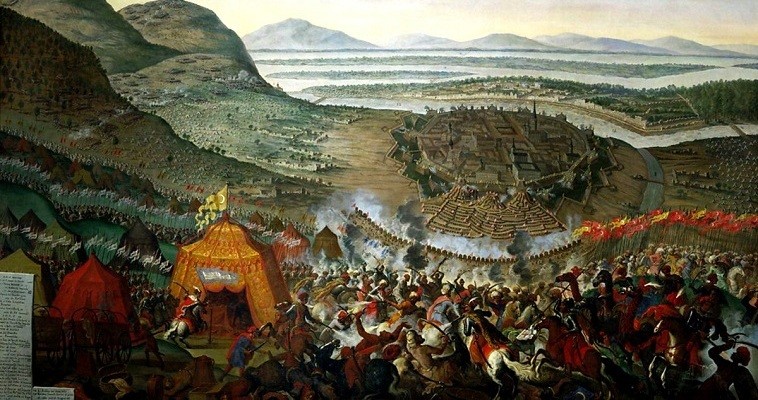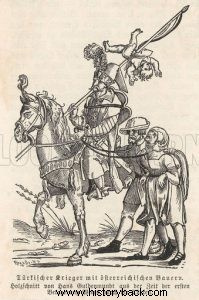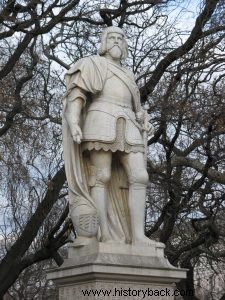
In 1526 the Ottoman armies of Sultan Suleiman, the so-called "magnificent", invaded Hungary and defeated, in Mohács, the army of King Laszlo II. The Habsburg Archduke Ferdinand was proclaimed King of Hungary in place of the deceased Laszlo. The noble Ioannis Zapolia also claimed the Hungarian throne, allying with the Turks.
On the occasion of this event Suleiman decided to conquer Vienna as well in order to spread the crescent and Islam in Western Europe as well. Suleiman gathered enormous forces. Depending on the source, between 120 and 300,000 men are estimated.
They included stout horsemen, elite janissaries and tens of thousands of azaps and other disorderly warriors. The Sultan started on May 10, 1529 from Polis. From the beginning, however, the omens were not good. Unexpected spring rains resulted in the Turks losing several heavy guns them and many of their transport animals to Bulgaria, while several men fell ill.
On the 6th of August the Turkish army reached Oziek in present day Croatia and on the 18th they reached the old battlefield of Mohács in Hungary. Zappolia's army joined him there . The Turks remained in the area occupying some fortresses and also Buda. Only Bratislava endured.
Waiting for the barbarians
On the other side the Austrians knew that Suleiman's target was Vienna and they tried to sort of – sort of organize its defense. Against the tens of thousands of Turks, however, they had only small forces to oppose. The regular forces in the city were small, initially, but some civilians were also recruited.
The governor of Austria, Wilhelm von Rogendorf, took over as chief type. But he put in charge of the defense a veteran soldier, the 70-year-old, but evergreen, Nicholas (Niklas) von Zalm . He arrived in the city at the head of a force of experienced soldiers, and immediately applied himself with zeal to strengthening the fortifications. In total, the defenders had 17,000 soldiers and about 3-4,000 civilians.
All the gates were sealed and the walls reinforced. The city walls were old, medieval and there was no hope of withstanding the pounding of the Turkish artillery. Therefore Zalm reinforced them in thickness and ordered the construction of bastions both on the walls inside and behind them as a second line of defense. Then he established his headquarters in the cathedral church of Agios Stefanos and awaited the enemy, who was not long in arriving. The bell tower of the church did not become an excellent observation post.
The Turks are coming
The Ottoman army, led by Suleiman and the Greek-born Grand Vizier Ibrahim Pargali Pasha, arrived relatively unscathed before the city on 24 September. The siege officially began on September 27. Suleiman sent three Austrian noble captives demanding the surrender of the city.
Suleiman's message read:“To the chief and other inhabitants of Vienna. If they become Muslims nothing will happen to you. But if you resist then, by Allah, your city will be turned into ashes and everyone, young and old, will be slaughtered" .
In response von Zalm sent Suleiman three Turkish prisoners but he gave no reply! Inside the city, "Noble and ordinary citizens swore to remain in the city as long as they lived and swore to die for the faith of Christ" .
The Turks had already committed horrendous crimes on their march, leaving a huge bloodline behind them. They did the same upon reaching the city, massacring the inhabitants of the surrounding villages and towns. According to testimonies "people were slaughtered or enslaved by the thousands, fetuses were ejected from the bellies of pregnant women and beaten, virgins were rushed to death".
Siege
Soon after the siege began. The Turks began to excavate the siege trenches (parallel) while their underminers (borermen) got to work digging underground galleries with the aim of undermining the walls from below. Soon the Turkish artillery began to fire. However, the loss of the heavy guns in Bulgaria had left the Turks with only lighter guns.
On September 28, however, it started to rain. The Turkish trenches filled with water and mud, and many kegs of gunpowder placed in the galleries had become wet so that the gunpowder would not explode. The rain stopped on September 30, but everything essentially had to start all over for Suleiman. Surely Heaven was not on his side.
Moreover, the defenders did not wait passively. Von Zalm organized constant sorties and counter-attacks destroying Turkish works to gain time. In one of the exits, the Austrians almost captured the vizier Ibrahim. The defenders also managed to neutralize many of the Turkish sewers.
On October 9, however, a Turkish sewer blew up, causing a 30m-long breach. on the wall. Immediately the Turkish verses poured out. But von Zalm was waiting for them. Behind the breach 8,000 of his men had been deployed and were waiting for the Turks with their lances and spears and their arquebuses ready. A stubborn battle ensued with heavy casualties on both sides, but the Austrians held on although von Zalm was wounded .
The Turks, in addition to their bloody defeat, were also faced with a lack of supplies and the rains hindered them. Even the janissaries began to resent it. So Suleiman decided to try a general attack with the aim of either taking the city or else retreating.
Final assault and retreat
Suleiman promised rewards, riches and positions to his men to cheer them up. With imams invoking Allah and the "prophet", drums beating, Suleiman tried to cheer his men. But it was in vain. Their morale had fallen. After a lifeless attack lasting two hours, the Turks withdrew. Humiliated Suleiman decided to retreat.
It was his first major defeat. With his head bowed, he made his way back. Vienna, "the golden apple tree", was not going to fall, nor Europe to become Muslim, at least then. Suleiman tried his luck once more by campaigning against Vienna in 1532 but never even reached the city. A few months after his victory, the brave von Zalm died, on May 4, 1530.

Turkish horseman with speared infant, drags the parents as slaves. The image is indicative of Turkish crimes.

Nicholas von Zalm.
